#cryovolcanic
Explore tagged Tumblr posts
Link
In this episode of SpaceTime, we explore the possibility of a hidden ocean on Uranus's moon Ariel. Discover the Webb Space Telescope's new insights into star formation and delve into the mysteries of neutron star mergers. Join us for these fascinating updates and more! 00:00:00 - This is spacetime series 27 episode 98 for broadcast on the 14 August 2024 00:00:43 - Growing speculation that Uranuss moon Ariel could harbour a hidden subsurface ocean 00:12:46 - Scientists use supercomputers to study how quickly black holes form from neutron star merger 00:16:30 - A new study claims thinking too hard can be unpleasant 00:19:22 - Apple releases new security updates for iPhones, iPads and Macs 00:19:59 - Google unveils new Pixel phones in Australia on Wednesday morning 00:22:02 - Spacetime is available every Monday, Wednesday and Friday through various podcasting services For more SpaceTime, visit our website at www.spacetimewithstuartgary.com www.bitesz.com Become a supporter of this podcast: https://www.spreaker.com/podcast/spacetime-with-stuart-gary--2458531/support
#ariel#carbon#cryovolcanic#dioxide#formation#hidden#ice#james#merger#monoxide#moon#neutron#ocean#radiolysis#space#star#subsurface#telescope#uranus#webb
0 notes
Text

It's a little sad to me just how limited the topographic map data we have of Titan is. The strips of yellow-brown across the map pictured above are the only areas where we have real radar altimetry, assembled as the Cassini spacecraft made fly-by measurements - everything in between is a best-guess interpolation. There's plenty of unanswered questions about the in-depth specifics of tectonism and cryovolcanism and the possibility that Titan's currently in a dry period and may have had bona-fide seas of liquid ethane (as opposed to the lakes we see today covering ~1% of the surface at the north pole) in the not too distant past here that we can barely even begin to tackle because our dataset is such a patchwork...
Of course, the Cassini data is of orders of magnitude better than being completely in the dark as to what things are like under Titan's global haze layer, as we were before the Cassini fly-bys and Huygens probe landing. The paper linked above applies a similar dataset sampling to Earth and successfully reconstructs the existence of all the continents, but does miss the Tibetan plateau and derive continental shapes that are... wonky. I really hope we send an orbiter with a suite of mapping instruments (2-micron IR LIDAR might actually work through the haze fairly well, plausibly with at least MOLA-level performance) sooner rather than later, so we can get data back before like 2050.
#If I'm totally honest I would have preferred an orbiter before the dragonfly quadcopter but that ship has sailed#text tag#paper tag#Titan
36 notes
·
View notes
Text
My headcanons for the location of the Third House because this is what my brain decided to focus on tonight:
References to tridents (the Tridentarii, Babs' triple bladed knife) probably place Ida on or near Neptune.
Names in the Third royal line represent purple flowers (Ianthe, Violabeth), possibly a reference to the myth of Clytie, an oceanid nymph.
Rather than living in some installation on a gaseous planet, it's possible a colony was set up on Triton, Neptune's largest moon.
Triton has a retrograde orbit, indicating that it was likely captured rather than formed in the planet's accretion disk. This means it would have been subject to significant tidal forces which would contribute to warming.
It also has a solid core, which would provide radiogenic heating.
Triton is tidally locked to Neptune, meaning that the same side of the moon always faces the planet. This means that its poles experience seasons as Neptune orbits the sun every 165 years, with one pole remaining in the sun for half the orbital period.
This constant sun exposure plus a greenhouse effect from nitrogen ice would trap in additional heat.
These various heating sources and cryovolcanic activity point to the likelihood of a subsurface water ocean.
In conclusion, civilization on Ida may take the form of a series of subaquatic installations where the inhabitants migrate between the two poles every ~80 years to preserve heat, which fits with both the ocean imagery and the purple flower/heliotrope imagery of turning to face the sun!
79 notes
·
View notes
Note
Ok but what about those top 5 moons?
WELL THANK YOU FOR ASKING
Mimas
we see you. death star ass
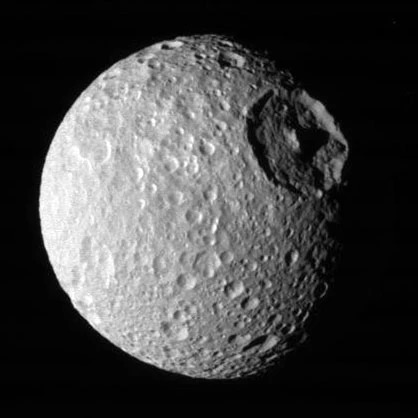
Titan
Yes it's cool that it's the second largest moon in the solar system and it has a dense atmosphere and lakes and rains of methane. But mostly it looks very soft and I want to pet it.
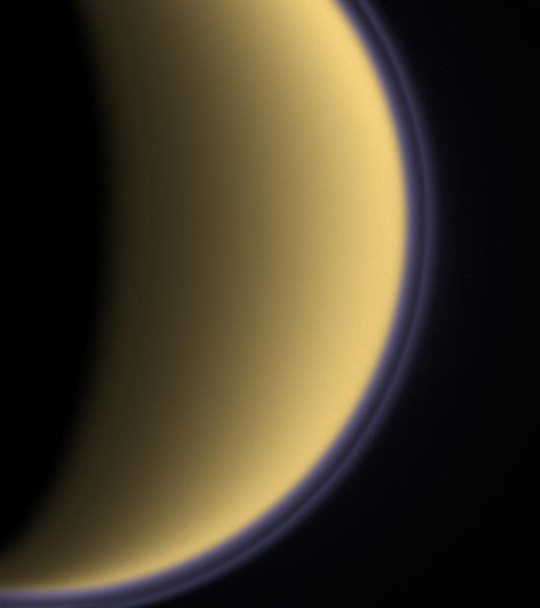
Io
Volcanoes. Volcanoes. Her volcanoes. Plumes seen from space. Tidal heating. Gravitational forces from proximity to Jupiter causing its surface to stretch up to 300 feet as it rotates. Thee most geologically active place in the solar system. Looks like pizza and smells like farts
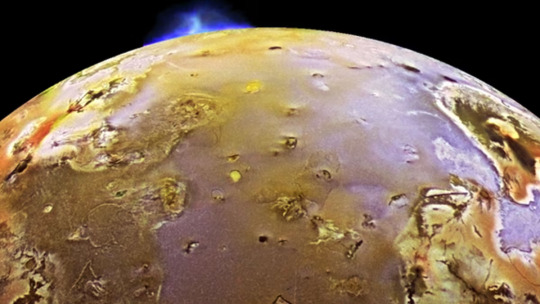
Enceladus
So so so pretty. Also: cryovolcanism!!! Ice plumes that add to Saturn's rings!! Subsurface ocean potentially harboring life!!!!
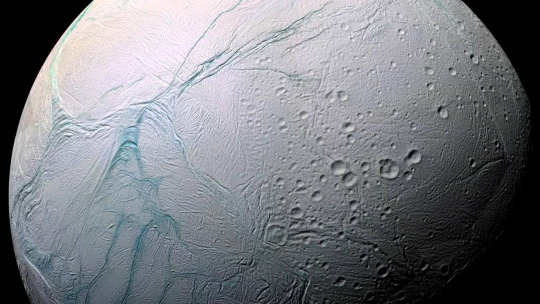
Pan
Shepherd moon orbiting inside Saturn's rings sweeping up ring particles around its equator. I love you funky little space pierogi you are my favorite.
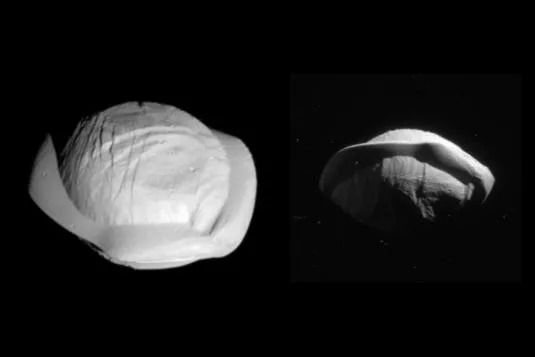
51 notes
·
View notes
Text
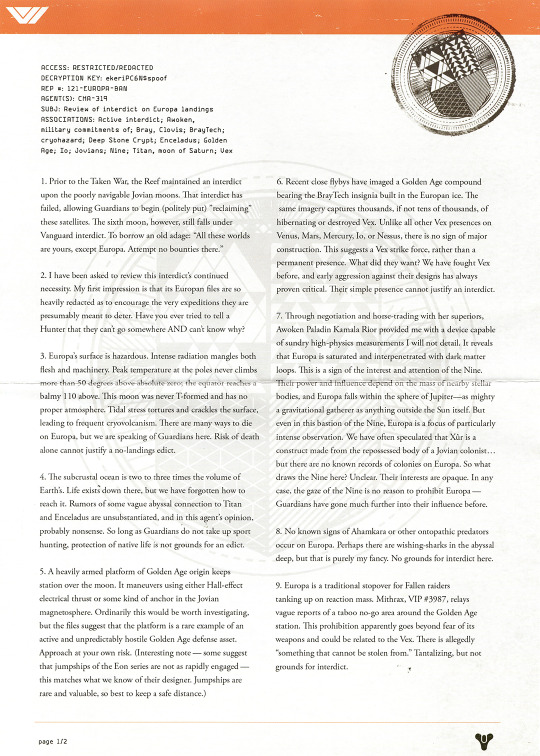

^ Communications to the Vanguard; Letter from the Stranger [Elisabeth "Elsie" Bray]
-----------------------------------------------------
Destiny 2 [Bungie] | Beyond Light [Collector's Edition]
ACCESS: RESTRICTED/REDACTED DECRYPTION KEY: ekeriPC6N$ spoof REP #: 121-EUROPA-BAN AGENT(S): CHA-319 SUBJ: Review of interdict on Europa landings. ASSOCIATIONS: Active interdict; Awoken, military commitments of; Bray, Clovis; Bray Tech; cryohazard; Deep Stone Crypt; Enceladus; Golden Age; Io; Jovians; Nine; Titan, moon of Saturn; Vex
1. Prior to the Taken War, the Reef maintained an interdict upon the poorly navigable Jovian moons. That interdict has failed, allowing Guardians to begin (politely put) "reclaiming" these satellites. The sixth moon, however, still falls under Vanguard interdict. To borrow an old adage: "All these worlds are yours, except Europa. Attempt no bounties there." 2. I have been asked to review this interdict's continued necessity. My first impression is that its Europan files are so heavily redacted as to encourage the very expeditions they are presumably meant to deter. Have you ever tried to tell a Hunter that they can't go somewhere AND can't know why? 3. Europa's surface is hazardous. Intense radiation mangles both flesh and machinery. Peak temperature at the poles never climbs more than 50 degrees above absolute zero; the equator reaches a balmy 110 above. This moon was never T-formed and has no proper atmosphere. Tidal stress tortures and crackles the surface, leading to frequent cryovolcanism. There are many ways to die on Europa, but we are speaking of Guardians here. Risk of death alone cannot justify a no-landings edict.
4. The subcrustal ocean is two to three times the volume of Earth's. Life exists down there, but we have forgotten how to reach it. Rumors of some vague abyssal connection to Titan and Enceladus are unsubstantiated, and in this agent's opinion, probably nonsense. So long as Guardians do not take up sport hunting, protection of native life is not grounds for an edict. 5. A heavily armed platform of Golden Age origin keeps station over the moon. It maneuvers using either Hall-effect electrical thrust or some kind of anchor in the Jovian magnetosphere. Ordinarily this would be worth investigating, but the files suggest that the platform is a rare example of an active and unpredictably hostile Golden Age defense asset. Approach at your own risk. (Interesting note-some suggest that jumpships of the Eon series are not as rapidly engaged - this matches what we know of their designer. Jumpships are rare and valuable, so best to keep a safe distance.) 6. Recent close flybys have imaged a Golden Age compound bearing the Bray Tech insignia built in the Europan ice. The same imagery captures thousands, if not tens of thousands, of hibernating or destroyed Vex. Unlike all other Vex presences on Venus, Mars, Mercury, Io, or Nessus, there is no sign of major construction. This suggests a Vex strike force, rather than a permanent presence. What did they want? We have fought Vex before, and early aggression against their designs has always proven critical. Their simple presence cannot justify an interdict.
7. Through negotiation and horse-trading with her superiors, Awoken Paladin Kamala Rior provided me with a device capable of sundry high-physics measurements I will not detail. It reveals that Europa is saturated and interpenetrated with dark matter loops. This is a sign of the interest and attention of the Nine. Their power and influence depend on the mass of nearby stellar bodies, and Europa falls within the sphere of Jupiter-as mighty a gravitational gatherer as anything outside the Sun itself. But even in this bastion of the Nine, Europa is a focus of particularly intense observation. We have often speculated that Xûr is a construct made from the repossessed body of a Jovian colonist… but there are no known records of colonies on Europa. So what draws the Nine here? Unclear. Their interests are opaque. In any case, the gaze of the Nine is no reason to prohibit Europa- Guardians have gone much further into their influence before. 8. No known signs of Ahamkara or other ontopathic predators occur on Europa. Perhaps there are wishing-sharks in the abyssal deep, but that is purely my fancy. No grounds for interdict here. 9. Europa is a traditional stopover for Fallen raiders tanking up on reaction mass. Mithrax, VIP #3987, relays vague reports of a taboo no-go area around the Golden Age station. This prohibition apparently goes beyond fear of its weapons and could be related to the Vex. There is allegedly "something that cannot be stolen from." Tantalizing, but not grounds for interdict. 10. Many Exos have fragmented memories concerning ice sheets and Jupiter in the sky. Europa would be a logical origin for those memories, especially given the presence of Bray Tech assets. This seems to militate towards an investigation.
11.The instruments Paladin Rior provided are extremely unreliable in the vicinity of Europa. I cannot determine whether this is a result of poor construction, my own inexpert use, or the presence of something aberrant. 12. This is hardly a well-vetted piece of intelligence, but something about the imagery and lore I've collected gives me an extremely bad feeling. Something is wrong here. 13. In conclusion, I cannot find strong strategic reasons to maintain the interdict on Europa. We lifted the interdict on the Moon not five years ago, resulting in a series of strategic key victories and intelligence findings… but also triggering the arrival of Oryx, an event that gave Ghaul his Light-suppressing technology and ultimately led to the awakening of the lunar intruder. Perhaps Europa will prove as consequential? We cannot shrink from new discoveries simply because they may lead to new challenges. Victory, after all, requires escalation.
I recommend LIFTING THE INTERDICT. MESSAGE ENDS [Recommendation refused on grounds of compartmentalized information. Unable to share; please trust that your analysis has not been ignored or discarded out of hand. Regrets - IKO/0061]
----------------------------------------------------- Guardian- This is an artifact of Darkness, and now I entrust it to you. Do not take this charge lightly. I have seen firsthand what its power an do Guardians who wield it… even to you. Like all new ground, it can prove treacherous to walk. Listen to your Little Light, and remember that you will live with choices forever. it you. My grandfather came to Europa before the Collapse to seek immortality. He thought he was chosen to lead humanity to the future. His experiments to this end were… hideous. Despite my qualms, collaborated with him. I accept my responsibility in full; I would have, know everything. "O nymph, in your orisons, be all my sins remember'd." You, nymph, but the principle holds, yes? We must know what he did with the power you now grasp. I have included a hard copy of the logs I've deciphered so far. Reader beware. My grandfather was worse than you know. Your stranger I remain, E
25 notes
·
View notes
Note
The other day I dreamed we found microbial life on Triton, in the ice, using ammonia not to freeze. We got to witness it live-ish as the probe very gently polished the ice away and observed the surface with its instrumentation. It was a very moving moment.
What's interesting is that I wasn't consciously aware of ammonia serving as a basis for life, and I don't remember the last time I thought about Triton... Prophetic dream??? Keep an eye out for Triton missions
First off HEY ANON IM SO SORRY I FORGOT ABOUT THIS ASK TIL NOW
Secondly, that sounds like a really cool dream!! Triton is a very interesting called shot for extraterrestrial life imo. It's VERY cold, far below the freezing point of pure nitrogen (let alone ammonia). However, it is strongly suspected to be a geologically active planetoid due to extreme tidal forces from Neptune (it orbits backwards!), and cryovolcanism has been observed on its surface which leads many to hypothesize the existence of a subsurface water ocean like many other gas giant moons (Europa, Ganymede, Enceladus, probably Dione and Rhea, etc). Given its abundance of surface nitrogen, I would not be surprised at all if that subsurface ocean had a substantial partial composition of ammonia, allowing it to stay liquid at much lower temperatures. Another thing Triton has in its favor is its density, a cool 2.1 g/cm3 - this indicates a significant portion of its internal composition (65-85%) is rocky and/or metallic!
Between the tidal-thermal energy, liquid aqueous ammonia, and relative abundance of heavier elements, it is reasonably plausible to envision life deep below the surface of Triton. But it would be pretty different to life on Earth! The best analog I can come up with are the unicellular organisms found several meters below the deep ocean floor on Earth: metabolizing at rates so slow that a single cell may live for up to a million years. These organisms would likely be completely dependent on chemical energy, though they may also exploit the heat gradients found in the environments around hydrothermal vents.
There is a hitch, though. At the moment there is some serious debate as to whether the spontaneous development of protobiotic systems (abiogenesis, for short) is even possible in subglacial ocean environments! The key point of contention is the necessity of wet/dry cycles, which can't really happen in an environment that is all water all the time! Gas bubbles around hydrothermal vents might help in this case, but there isn't enough research for a real consensus.
Regardless of whether life lurks inside Triton, I desperately hope some space agency sends a dedicated probe out there soon. We are sorely lacking on information about our ice giants and their moons!!!
#thanks anon!#hope you're still watching this blog lol I don't know who you are#spy answers asks#spy has thoughts#space#science#biology#astrobiology#speculative biology#specbio
12 notes
·
View notes
Text

cardtober day 22
honestly, I think the dwarf planets are going by much quicker, just because they're so small. but I feel they might be too small, as most of the card is taken up by stars. but I also don't want them to be the same size as Jupiter.
anyway, Orcus is named after the Etruscan god of the underworld, similar to Pluto. it's very small, cold, and (like many other trans-neptunian objects) likely has cryovolcanic activity.
19 notes
·
View notes
Text



Did dwarf planet Ceres originate in the asteroid belt?
by Max Planck Society
The dwarf planet Ceres has a diameter of almost 1,000 kilometers and is located in the asteroid belt. In the television series "The Expanse," Ceres gained new fame as the main base of the so-called 'belters': in this series, which is based on real physics, humans colonize the asteroid belt for mining.
Ceres is no less prominent in the real world either. For a long time, however, it was not entirely clear whether the dwarf planet had formed in the asteroid belt or whether it had migrated inwards from the edge of the solar system. A research team led by the Max Planck Institute for solar system Research in Göttingen has found ammonium-rich deposits in the Consus crater in data from NASA's Dawn space probe, which reveal a lot about Ceres' origin.
Dwarf planet Ceres is an unusual "inhabitant" of the asteroid belt. With a diameter of around 960 kilometers, it is not only the largest body between the orbits of Mars and Jupiter; unlike its rather simple "fellow inhabitants," it is also characterized by an extremely complex and varied geology. Years ago, NASA's Dawn space probe discovered widespread ammonium deposits on the surface of Ceres.
Some researchers assume that frozen ammonium played a role in the formation of the dwarf planet. However, ammonium is only stable in the outer solar system, which indicates an origin far from the asteroid belt. However, new findings from the Consus crater speak against this.
Freezing vulcanism
Ceres appeared to have been the scene of unique cryovolcanism until recently—and probably still is. The underlying data was obtained by NASA's Dawn space probe when it studied Ceres up close from 2015 to 2018. The data point to an eventful past in which Ceres changed and evolved over many billions of years.
Light-colored, whitish salt deposits can be found in several impact craters. Deposits in the Consus crater could indicate ammonium-rich material that has reached the surface from the depths of the dwarf planet due to Ceres' volcanism. More precisely, researchers believe the deposits are remnants of a brine that has seeped to the surface from a liquid layer between the mantle and crust over many billions of years.
Images and measurement data from the Consus crater, which the team has now analyzed in greater detail than ever before, now show such material that is yellowish in color. The presence of ammonium, therefore, does not necessarily indicate an origin in the outer solar system—Ceres could have formed where it is orbiting today.
A crater within a crater
Conus Crater is located on Ceres' southern hemisphere. With a diameter of around 64 kilometers, it is not one of the dwarf planet's particularly large impact craters. Images taken by Dawn's scientific camera system, which was developed and built under the lead of the MPS, show a circumferential crater wall that rises about 4.5 kilometers above the crater floor and has partially eroded inwards.
It encloses a smaller crater covering an area of about 15 kilometers by eleven kilometers that dominates the eastern half of Consus' crater floor. The yellowish, bright material is found in isolated speckles exclusively on the edge of the smaller crater and in an area slightly to the east of it.
As the new analysis of data from the camera system and the VIR spectrometer suggests, the yellowish bright material in Consus Crater is rich in ammonium. In traces, the compound, which differs from ammonia by an additional hydrogen ion, is almost omnipresent on the surface of Ceres in the form of ammonium-rich minerals. The research is published in the Journal of Geophysical Research: Planets.
In the past, scientists believed that these minerals could only have formed through contact with ammonium ice in the cold at the outer edge of the solar system, where frozen ammonium is stable over long periods of time. In closer proximity to the sun, it evaporates quickly. Ceres must therefore have formed at the edge of the solar system and only later "relocated" to the asteroid belt, they inferred.
The current study now shows for the first time a connection between ammonium and the salty brine from Ceres' interior. The team argues that, therefore, the dwarf planet's origin does not necessarily have to be in the outer solar system. Ceres could also be truly native to the asteroid belt.
Ammonium from the depths
The researchers assume that the components of ammonium were already contained in Ceres' original building blocks. As ammonium does not combine with the typical minerals in Ceres' mantle, it gradually accumulated in a thick layer of brine that extended globally between the dwarf planet's mantle and crust.
Cryovolcanic activity caused the ammonium-rich brine to rise repeatedly over the course of billions of years, and the ammonium it contained gradually seeped into the large-scale phyllosilicates of Ceres' crust. Phyllosilicates, which are characterized by a layer-like crystal structure, are also widespread on Earth, for example in clayey soils.
"The minerals in Ceres' crust possibly absorbed the ammonium over many billions of years like a kind of sponge," explains MPS scientist Dr. Andreas Nathues, first author of the current study and former Lead Investigator of Dawn's camera team.
There is much to suggest that the concentration of ammonium is greater in deeper layers of the crust than near the surface. The few places on the surface of Ceres where conspicuous patches of the yellowish-bright material can be found outside Consus Crater are also located within deep craters.
As the current study shows in detail, the impact that created the small eastern crater only 280 million years ago is likely to have exposed material from the deep, particularly ammonium-rich layers in Consus Crater. The yellowish-bright speckles to the east of the smaller crater are material that was ejected as a result of the impact.
"At 450 million years, Consus Crater is not particularly old by geological standards, but it is one of the oldest surviving structures on Ceres. Due to its deep excavation, it gives us access to processes that took place in the interior of Ceres over many billions of years—and is thus a kind of window into the dwarf planet's past," says MPS researcher Dr. Ranjan Sarkar, a co-author of the study.
TOP IMAGE: Arriving at its destination: This illustration shows how the Dawn space probe reaches the dwarf planet Ceres. Credit: NASA/JPL-Caltech
CENTRE IMAGE: Consus Crater is located in the southern hemisphere of dwarf planet Ceres. The most striking structure in its interior is a smaller crater (“floor crater”) in its eastern half. A flat central mountain rises up in the center of Consus Crater. Credit: Max Planck Society
LOWER IMAGE: The yellowish bright material, marked here as “yBM”, is found exclusively on the edge of the smaller crater and in its immediate eastern vicinity. Credit: Max Planck Society
3 notes
·
View notes
Text
Little side project I've been mentally tinkering with lately, trying to come up with a world with a similar vibe to that world we see in the beginning of Alien but a bit more of a hard science foundation (though nothing super-rigorous). Thought this would be appropriate to post on Halloween originally, but I didn't find the time or energy to write it up then.
Start with a small red dwarf star, maybe just above the hydrogen fusion threshold, around 80-100 Jupiter masses. Significantly, it is a flare star.
Put a gas giant around it, orbiting somewhere between .1-.5 AU. Give this gas giant a bunch of satellites, including three to five planet-sized ones. The innermost or second-innermost big satellite is the one we'll be focusing on.
This satellite is small by planet standards but big by moon standards, maybe somewhere between Titan and Mars in mass. It's big enough to hold onto a significant atmosphere. It's got a pretty typical composition for a world that formed beyond the snow line; lots water, ammonia, carbon, and sulfur. It's tidelocked to the gas giant, but gravitational interactions with outer moons pumps up the eccentricity of its orbit, which means it experiences substantial eccentricity tides, enough to cause substantial tidal heating and drive substantial volcanism. It's a lot warmer than Titan but its surface is still pretty cold by our standards, average surface temperature is maybe around -35 C (238 K).
It's got an icy crust of mostly water ice overlying a water/ammonia ocean, which in turn overlies the silicon/carbon/metal core (maybe with a thick layer of exotic high pressure "ices" between the core and the ocean). Tidal forces cause this icy crust to flex and crack and generate a lot of cryovolcanism; lots of water and ammonia comes belching out at the surface. The water mostly comes out as liquid with lots of carbon and sulfur compounds dissolved in it, and as the surface is pretty cold most of it freezes pretty quickly. The ammonia is a bit more interesting...
This world has a pretty thick atmosphere, mostly ammonia and methane, with a little hydrogen sulfide. Orbiting a flare star, the top of the atmosphere gets significant UV which causes some photolysis, so there's also some ethane, butane, and other longer hydrocarbons, and there may also be some (molecular) nitrogen (likely quite a lot of that, as it's not very reactive so it'll tend to build up - same reason it's the primary component of our atmosphere) and some carbon dioxide and other oxidized chemicals. It's certainly at least 1 bar, maybe quite a bit more, and probably creates a substantial greenhouse effect.
The surface temperature is close to the boiling point of ammonia, so this is a world where ammonia can exist in large quantities as gas and liquid; it's a world with an ammonia cycle, kind of like our water cycle. Ammonia gets belched out of the interior, goes up, condenses, forms ammonia clouds, and rains down. On the rugged surface, these ammonia rains form pools and lakes of ammonia/water mixture - ammonia in water acts as an antifreeze, so water/ammonia mixture stays liquid well below 0 C. This ammonia/water mixture then tends to find its way into the many cracks in the icy crust and eventually returns to the global water/ammonia ocean deep underground, completing the cycle. An Io-like level of volcanism means ammonia is constantly being pumped out of the interior in large quantities and then returning back to the interior this way, which generates a thick global ammonia cloud layer and frequent ammonia rain.
Meanwhile, higher up in the atmosphere, the UV radiation created by the big solar flares causes the formation of long hydrocarbons and also carbon dioxide, sulfur dioxide, nitrogen oxides, and other oxidized compounds. Some of these compounds (e.g. sulfur dioxide and nitrogen dioxide) are liquids at the temperature of this planet. The result is a tholin haze, like on Titan, and periodic rains of these chemicals from the haze layer to the surface. These liquids pool on the surface, contaminate or enrich (depending on how you look at it) the surface water/ammonia pools, and become incorporated into the icy crust, either directly by mixing with water that then freezes or by becoming part of the water/ammonia inner ocean and then bubbling back up as part of the cryovolcanic water "lava."
The ammonia cloud layer and tholin haze layer blocks a lot of the sunlight that might otherwise reach the surface. And that sunlight is pretty dim to begin with. It's probably only something like 5% to 20% the intensity of the sunlight Earth gets to begin with - and that's across the whole spectrum; a cool star like this puts out mostly infrared light invisible to humans. We can use Proxima Centauri as a reference; Proxima Centauri's bolometric luminosity, its total energy output, is .00152 solar, but its visual luminosity, its brightness in visible light, is a mere .0000562 solar. If you were in the habitable zone of Proxima Centauri, it would be about 4% the visual brightness of Sol seen from Earth! This world, outside the habitable zone, probably has something more like 1-2% the brightness of daylight on Earth at the top of the haze layer, or less. This would probably be bright enough to be subjectively experienced as daylight by humans. But then a lot of that gets reflected or absorbed by the tholin haze layer and the thick, stormy global ammonia cloud layer below it. Daylight on the actual surface is going to be pretty dim!
Note: while this world is usually globally well below freezing, the biggest flares may raise the surface temperature above the freezing point of water locally, near the equator, for a short time. This might tend to form big but very shallow temporary seas of liquid water which would then quickly freeze back over into broad, flat ice plains, which would then tend to gradually get broken up into rougher terrain by geologic activity. In regions that didn't get quite that hot, it would tend to cause temporary near-surface melting and softening that might give the terrain a distinctive look. These mega-flares might also pump a lot of water vapor into the atmosphere, which would increase the greenhouse effect for a while and then come back down as snow, hail, or water rain - in this geology, water rain would be kind of like a rain of lava.
Subjective impressions on the surface:
Daylight would be very dim; it might look more like a dim cloudy twilight to humans. The sky would be darkly clouded, and visibility would also often be reduced by frequent ammonia rains and fogs and maybe by less frequent water snow and hail.
Deep cold, but not very deep; boiling point of ammonia is around -30 C; Antarctica cold, Mars cold, not Titan cold.
There is no free oxygen and the atmosphere is poisonous. After an EVA the suits and equipment will probably smell bad (I guess a mix of rotten eggs, old urine, and kind of a motor oil smell).
The surface is very rugged. Low gravity (smaller mass than Earth plus a lot less dense) means there's lots of tall, narrow pinnacles and the like. There's lots of cryovolcanoes with steaming vents. Much of the water ice "rock" is colorful in the same kind of way as Io and some hot springs on Earth (though you'd probably need to shine a light on it to notice), but a lot of it is black; the color varies with the balance of carbon, nitrogen, and sulfur compounds that got incorporated into it. Earthquakes are common.
It's stormy; it rains a lot (the rain is mostly ammonia). The liquid forms pools and lakes (of various mixes of ammonia, water, and tholin sludge). The liquid in these pools and lakes often appears to be some kind of dirty sludge, often but not always dark; it's heavily enriched/contaminated with hydrocarbons and nitrogen and sulfur compounds.
The nature of the ammonia cycle (lots of it constantly bubbling up from the interior, relatively short residence in the atmosphere and on the surface, quickly going back to the interior) and the terrain (very rugged, lots of deep cracks in the icy crust) means this is a world of ponds and relatively small but deep lakes, not seas and oceans. This is actually probably fortunate for any visitors; the strong eccentricity tides mean any body of surface liquid that stretches across a significant percent of the east-west extent of the world will have huge tides. Even small seas might slosh around in their beds like water in an unstable container, locally rising and falling many meters each day. The global ocean probably has very high tides, but since there is no emerged land and the ice crust rides on top of it, these are experienced on the surface as the "land" rising and falling, not directly perceptible but the earthquakes and other geologic activity it would generates would be very noticeable.
Life?
This world is a much better exobiological prospect than Titan. Much warmer (though still cold by our standards). Much more energy available, both from sunlight and from tidal heating. All that tholin sludge raining down could be nutrition for living things. Bonus; some of the gas giant's other big satellites may have substantial atmospheres and surface liquid too, opening the possibility of local panspermia. It'd probably still be a much lower energy biosphere than Earth, but it's quite plausible that there could be simple single-cell organisms in the water/ammonia lakes and maybe even in the subsurface ocean.
Space Jockey preservation?
Any long-derelict crashed alien spacecraft on this world would probably have sustained significant damage from earthquakes, rain, and temperature changes over the millennia. If built tough enough, it might still be mostly in a handful of pieces, but it'd look old and weather-beaten. If close to the equator or in an area with lots of crust turn-over, it might have become buried or even eventually ended up in the subsurface ocean; to have it remain above ground, better to put it far away from the equator and in an area where the water ice crust is relatively stable.
What about a suitably atmospheric giant alien corpse in the cockpit? The temperature is below freezing, but not very far below freezing (of pure water), and maybe with some brief occasional excursions into above freezing conditions. Assuming any life support systems failed soon after the being's death, I think this would probably lead to such a corpse becoming an ice mummy instead of a corpsicle or a clean (exo)skeleton; I guess -30 C or so is probably warm enough that its bodily fluids would gradually sublimate away, basically it'd get freeze-dried. There might be some thaw/freeze damage along the way, from thaw/freeze episodes that happened before all the water was gone (and, after that, more gradual damage from thermal expansion and contraction and the like). This is assuming the cockpit stays relatively intact, so we don't have to worry about water/ammonia rain getting into it. The corpse might be occasionally exposed to warmth and humidity after really big mega-flares, which would probably not be good for its preservation. My guess is a Jockey-equivalent somewhere between thousands and hundreds of thousands of years old might be still in one piece but degraded enough you'd need to use some imagination to picture the creature in life.
Differences from Alien LV-426:
A water/ammonia lake world would probably need a lot more sunlight than a methane lake world like Titan. I was going to note that I'm not sure if it's plausible for a gas giant in an orbit like that to have nice bright presumably icy rings like Saturn, but actually, assuming the planet in the opening credits scene is supposed to be the gas giant LV-426 orbits, I don't think it has those either; those rings look fairly dim (as does the gas giant itself, though we're mostly seeing its night side).
Also, points in defense of the gas giant this moon orbits potentially having visually bright rings:
This world has a substantial atmosphere and methane and ammonia are greenhouse gasses. It also has tidal heating as a non-trivial component of its energy budget. Its surface temperature is probably a lot higher than the surface temperature of a ring particle.
Earth's moon is rock (pretty dark rock IIRC) but still looks shiny and bright to us; rings with ring particle composition resembling a S or C type asteroid might still look pretty bright.
Terraforming this world would probably be pretty much a non-starter. It just doesn't get much light, and even if you somehow did manage to raise the surface temperature above 0 C, you'd just a big dirty ocean with no emerged land; it has way too much water to ever be Earth-like unless something removed probably a majority of its mass, and with an Earth-like radiation environment it might be too small to hold on to a significant atmosphere, especially after you've stripped it down to the core. Plus, the core probably resembles a C-type asteroid in composition; expose it and you'd get a carbon world, which probably wouldn't be particularly habitable for humans. Also, to get a really Earthlike world you'd need to circularize the orbit to get rid of the monster tides and you'd need to do something about the solar flares.
I might do something with this idea in my own sci fi universe, but I don't know what.
8 notes
·
View notes
Text
Found the source, or at least a possible source. Warning: it's from the Jerusalem Post, not sure if simply clicking on the article gives money to the Israeli gov? Either way, for those who don't want to click, a synopsis:
Comet 12P/Pons-Brooks is a cryovolcanic comet that orbits the Sun every 71 years. After a possible volcanic eruption, it now has what seems to be two massive horns.
A massive comet heading towards the Sun has seemingly sprouted a set of gigantic bright horns after it underwent a bright and cold volcanic eruption, according to images shared by the Comet Chasers, a research group led by Helen Usher of Cardiff/The Open Universities.
The comet in question is 12P/Pons-Brooks, a gigantic comet thought to be around 34 kilometers in diameter. For context, that's around the entire length of the border between Austria and Lichtenstein.
The comet was officially discovered in the 1800s, but never noted to have these "horns" before—which are around 7,000 times wider than the comet itself.
Comets are mostly made of dust, gas, and ice, and surrounded by a gas cloud called a coma which forms the tail. 12P is a cryovolcanic comet, meaning it has so much gas and ice buildup that it eventually explodes.
The horns themselves, which haven't been observed on other similar comets, is likely due to 12P's irregular shape.

Comet 12P
3K notes
·
View notes
Text
Surprised Russian school kids discover Arctic island has vanished after comparing satellite images
The cryovolcanic “centaur” comet 29P/Schwassmann-Wachmann has erupted four times in less than 48 hours, becoming unusually bright in the process. It is the most powerful outburst from the city-size oddball in more than three years. Continue reading Surprised Russian school kids discover Arctic island has vanished after comparing satellite images
0 notes
Link
Join us for SpaceTime Series 27 Episode 65, where we uncover the latest cosmic revelations and scientific advancements. First, we delve into the intriguing new features discovered in high-resolution images of Jupiter's icy moon Europa. Captured by NASA's Juno spacecraft, these images reveal signs of plume activity and ice shell disruption, providing clues about the moon's subsurface ocean and its potential to support life. Next, we explore a groundbreaking model explaining the formation of free-floating planets. Recent findings suggest that gravitational perturbations in dense star clusters could eject giant planets, leading them to orbit each other as they drift through interstellar space. Finally, we report on NASA's Perseverance rover, which has collected its 24th rock sample on Mars. This new sample, rich in carbonate and silica, holds promise for understanding the Red Planet's ancient habitability and potential signs of past life. 00:00 This is SpaceTime Series 27, Episode 65, for broadcast on 29 May 2024 00:44 New features discovered in high-resolution images of Jupiter's icy moon Europa 09:18 A new model to explain the formation of free-floating planets 16:09 NASA's Perseverance rover collects its 24th rock sample on Mars 18:28 A new study warns that fish oil supplements have been associated with a 13% increased risk of developing atrial fibrillation 26:05 SpaceTime is available every Monday, Wednesday, and Friday through various podcast providers Support the show and access ad-free episodes at https://www.bitesz.com/show/spacetime/. Follow our cosmic conversations on X @stuartgary, Instagram, YouTube, and Facebook. Join us as we unravel the mysteries of the universe, one episode at a time. Sponsor Offer This episode is proudly supported by NordPass. Secure your digital journey across the cosmos with a password manager you can trust. Find your stellar security solution at https://www.bitesz.com/nordpass. Listen to SpaceTime on your favorite podcast app including Apple Podcasts, Spotify, YouTube Music, or wherever you get your podcasts. Support SpaceTime Become a supporter of SpaceTime: https://www.bitesz.com/show/spacetime/support/ www.bitesz.com
#clipper#cryovolcanic#esa#europa#ice#jovian#juice#juno#mission#moon#nasa#ocean#planetary#plumes#polar#science#spacecraft#subsurface#true#wander
1 note
·
View note
Text
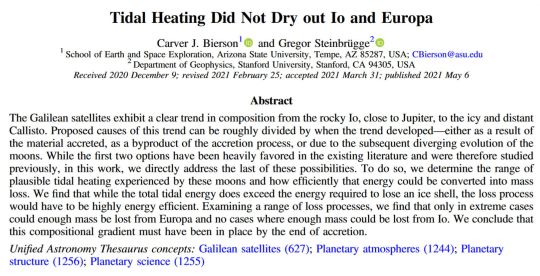
This is a fun paper - I'd always kind of assumed the reason Io and Europa are relatively* dry is because of their high tidal heating having desiccated their surfaces. Seems this is plausibly not actually the case! More likely that they just formed inwards of the ice-line of the jovian circumplanetary disk, similarly to how the inner planets in the Solar System are rocky and the outer planets and moons are volatile-rich.
Particularly interesting to me for worldbuilding was this bit:
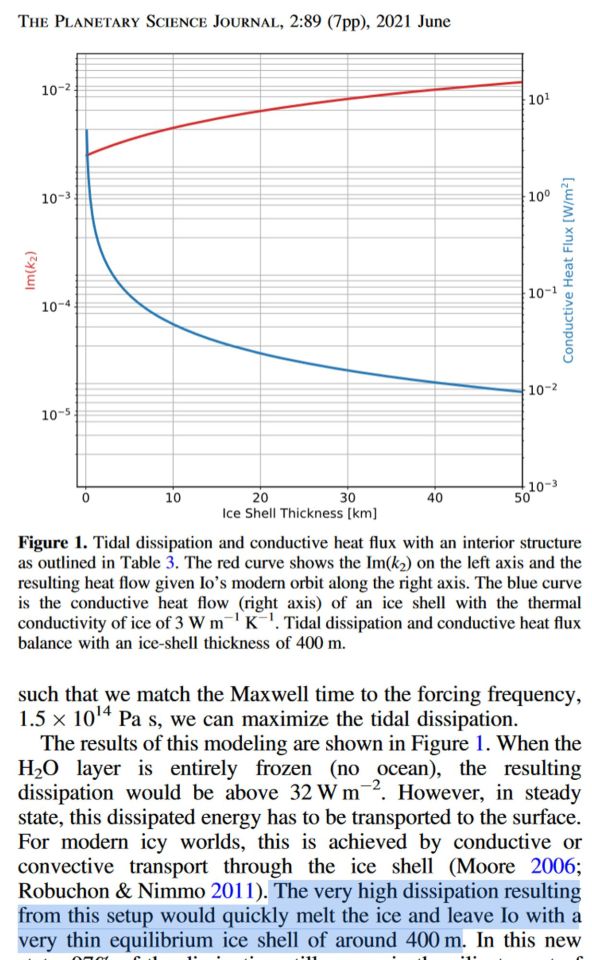
Actual numbers for the correlation between tidal heating and ice shell thickness! I've always wondered just how much internal heat flux you'd need for a super-thin ice shell that could let some visible light through (like you see under the thin sea ice in the Arctic and Antarctic oceans) in areas with locally thinned ice above hydrothermal upwellings. Turns out the answer is "quite a bit, probably a bit more than 10x the heat flow of present-day Io", but plausibly not completely unachievable**, especially with the mention of periods of high-eccentricity - and concomitant high tidal heating - in the histories of moon systems that exhibit Laplace resonance. The more exciting thing is that this implies that a moon with a higher water mass fraction could migrate into an Io-like orbit and not be desiccated, which could yield some interesting cryovolcanism from the thinned out ice shell - plausibly even temporary melt lakes like the ones which we've seen frozen-out remnants of on Triton!
(*) Europa is of course famous for being a wet moon with an ocean, but notably it only has a water mass fraction of about 5-9 percent. While being about three times the mass of all the water in all the oceans on Earth, this is teeny-tiny in comparison to Ganymede's water mass fraction of 50 to 30 percent - tens of times the total surface water inventory of the Earth! Io, on the other hand, is very very dry to the best of our knowledge. Unpleasant place.
(**) This becomes far more reasonable with a larger icy moon in a younger star system like Epsilon Eridani (age cca 400-800 million years), where the residual heat of formation and radionuclide decay in the hearts of these worlds has had less time to diminish.
11 notes
·
View notes
Text
Enceladus is mostly covered by fresh, clean ice, making it one of the most reflective bodies of the Solar System. Consequently, its surface temperature at noon reaches only −198 °C (75 K). In spite of that, its interior contains liquid water, heated by tidal interactions with Saturn and nearby moons. Cassini flew through a cryovolcanic plume, and detected organic molecules mixed in with H2O - a tantalizing discovery to those scientists looking for signs of extra-terrestrial life.

The Cassini spacecraft imaged the cratered northern latitudes of Saturn's geologically active moon Enceladus while the planet's rings peek through in the distance
336 notes
·
View notes
Text
Cryovolcanic "Devil comet" is now visible from Earth • Earth.com
0 notes
Text
Explosive 'devil comet' returns for 1st time in 71 years during April 8 eclipse, NASA says
ABC News By Leah Sarnoff and Mary KekatosMarch 18, 2024, 2:00 PM A rare and massive comet with a devilish nickname is set to pass by Earth for the first time in 71 years and may be visible during the highly anticipated April 8 total solar eclipse, according to NASA. Officially named comet 12P/Pons-Brooks, the cryovolcanic comet is known as the “devil comet” due to its formation of two “horns”…

View On WordPress
1 note
·
View note